25 min to read
Digital Marketing Funnel: What is it and how to create a successful one?
Introductory video on marketing funnels
What Is a Digital Marketing Funnel?
A Digital marketing funnel is a strategic model that represents complete journey of your customers in their buying journey, and highlights all the steps they take from the moment they get to know about the product to the final moment of purchasing it. The purpose of digital marketing funnel is to acquire qualified traffic at the top, and nurture them with content marketing and other forms of framework to finally convert them into customers.
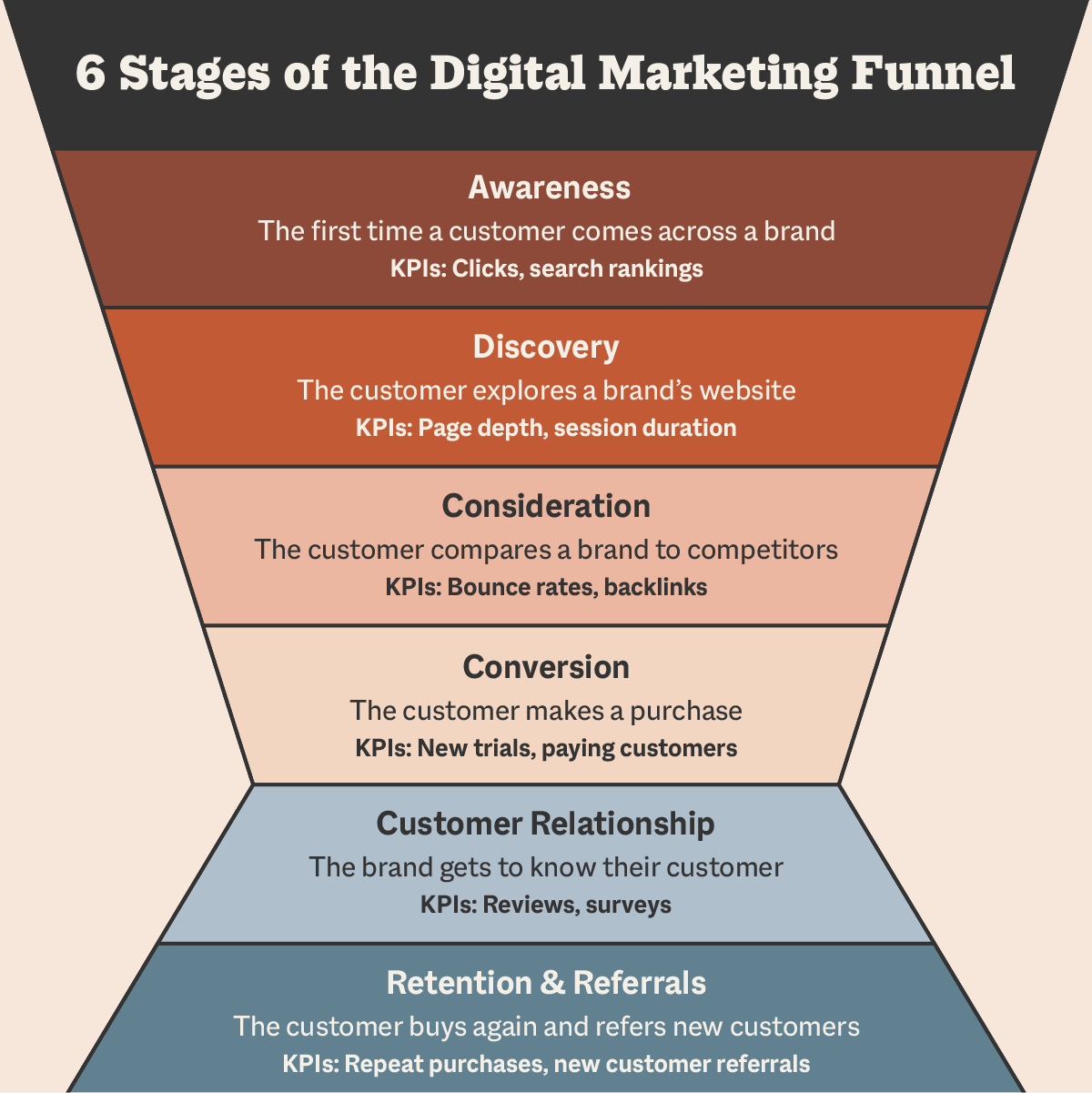
Marketing Funnel
A digital marketing funnel is created when you map out the different stages a customer goes through from the time they first hear about your product or service to the point where they either buy or abandon it. At each stage of the funnel, you'll want to put different strategies and techniques in place to encourage customers to move further down the funnel and closer to making a purchase.
For example, you might use social media to generate awareness about your product, email marketing to get people interested, and paid ads to drive traffic to your website.
The key is continuously testing and tweak your funnel until you find what works best for your business.
Work with us, the leading digital marketing agency to assist you in digital marketing.
When you are trying to market your product to an audience base, it is quite factual that people won't buy products instantly. Instead, there is a complete process behind the customer journey from knowing about the product to purchasing it. When you are selling your product to a customer, you need to understand the various characteristics and stages that a customer goes through before purchasing your product.
The first step to a successful customer journey and a digital marketing funnel is to understand the target audience. The classic mistake in marketing that most people tend to make is assuming that everybody is their audience, and they could sell to everyone. However, it is just a waste of time, energy, and resources to think this way. People travel from awareness interest desire and then action stage in the customer journey where they purchase your product.
Download for free our digital marketing funnel template
Use our template to design a comprehensive digital marketing funnel, using a mix of media strategy and organic traffic.
DOWLOAD FREE DIGITAL MARKETING FUNNEL TEMPLATE HERE!
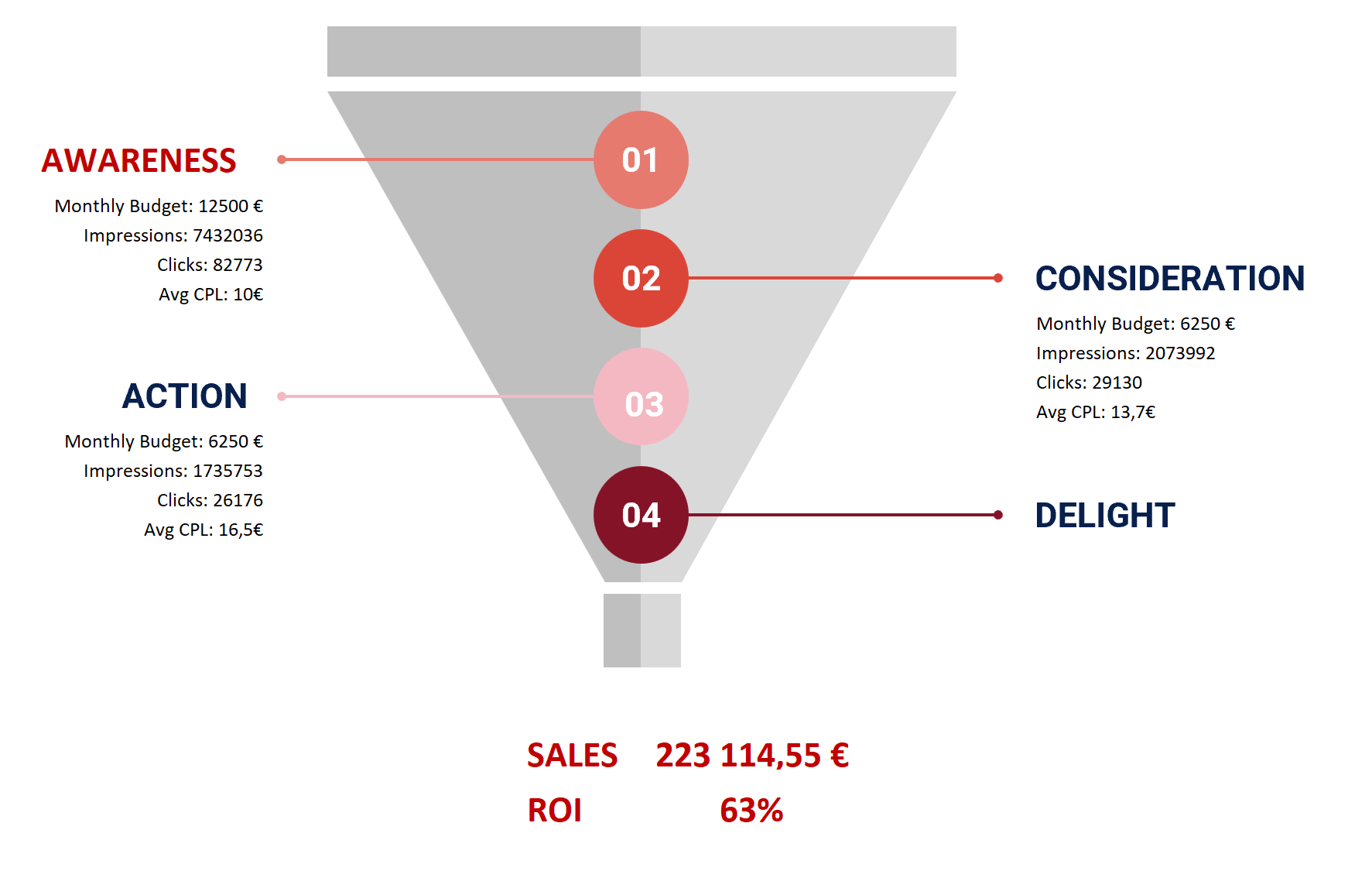
What is a marketing funnel?
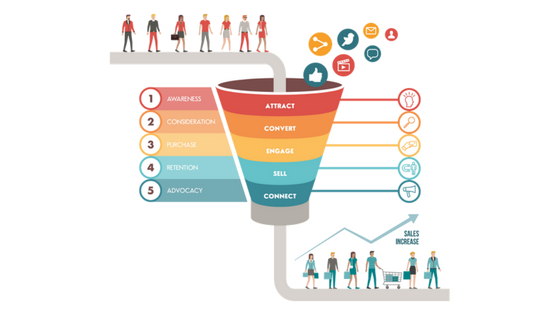
Funnel Representation
A marketing funnel is a visual and strategic representation of the steps that a customer takes in the entire journey from the moment they realize the problem till they become your customer. Marketers have widely accepted this concept, and they have been using this marketing funnel to achieve success in marketing actions. To succeed in your marketing campaign, it is highly recommended to better segment your marketing actions based on the content ads and the messages you were trying to put forward to your audience.
A person who has just realized that they may need a marketing agency for their project that will take place after three months would need to be marketed in a completely different manner than a person who has to take action within a few days. In the former case, you would like to do inbound marketing(SEO) and attract potential customers with your blogs, infographics, and LinkedIn post(if they search for potential agencies on LinkedIn) to ensure that they see you as an authority in the marketing niche. However, the latter potential customer needs to hear instantly from you. You may target them with Google ads or outbound marketing and present a completely different marketing message to influence their decision in your favor.
Why do you need a digital marketing funnel?
Many marketers suffer a loss with their paid campaigns on social media marketing, whereas others achieve a return on investment of 3X to 4X. Is there any magical ingredient? No. Simply allocating budget and throwing money recklessly on paid ads or any form of marketing would never generate results unless you have a strong foundation. Every firm that is investing in marketing works to have a good and positive return on investment by properly knowing what they are upto.
A digital marketing funnel helps you understand your target audience, which means you could have multiple opportunities to connect with your prospects at their preferred time and platform to impress them with your brand message and converse directly with them.
For example, if you’re a lawyer, investing in SEO for lawyers can be an excellent way to attract clients who are looking for legal services. You can use SEO to ensure that your website ranks on the first page of search engine results pages, and also focus on local SEO so that people in your area are more likely to find you. Additionally, you can create content related to legal matters that will help educate prospective clients about the services you offer. This will increase the likelihood that potential clients will contact you when they need legal assistance.
When you know your audience, you can easily create personalized content based on their stage in the customer journey. The world loves personalization, and there is no doubt about that. A proper digital marketing funnel could help you enhance personalization where you easily create content or copywriting focused on your audience. When you distribute a budget for various digital marketing channels, then it is evident that you would be generating a higher return on investment for every single buck spent.
Difference between Sales Funnel and Marketing Funnel
Your marketing funnel establishes points of contact and provides incentives for prospects to make a purchase. Meanwhile, your sales funnel outlines the concrete steps you employ to persuade individuals into making a buying decision.
|
Aspect
|
Sales Funnel
|
Marketing Funnel
|
|---|---|---|
|
Main Focus
|
Conversion of leads into customers
|
Generating awareness and interest among prospects
|
|
Customer Interaction
|
Personalized interaction by sales reps
|
Interaction with content and marketing materials
|
|
Key Interaction Points
|
- Answering questions
|
- Blog posts
|
|
|
- Providing materials (tutorials, pitch decks, etc.)
|
- Video clips
|
|
|
- Offering deals or discounts
|
- E-books
|
|
Role Transition
|
Lead transitions from marketing to sales phase
|
Transition from prospect to lead
|
|
Goal
|
Close the sale and convert leads into customers
|
Nurture and educate prospects
|
|
Personalization
|
Highly personalized approach tailored to the lead
|
Generalized content for a broader audience
|
|
Messaging Consistency
|
Alignment between marketing promises and sales pitch
|
Ensuring a consistent message across channels
|
|
Potential Challenges
|
- Maintaining a seamless handover from marketing
|
- Keeping prospects engaged throughout the funnel
|
|
|
to sales
|
- Balancing between education and promotion
|
|
|
- Addressing potential discrepancies in messaging
|
- Adapting to changes in customer behavior
|
|
Importance of Cooperation
|
Both funnels must work together to ensure a smooth
|
Collaboration between marketing and sales teams
|
|
|
customer journey and consistent messaging
|
for a unified customer experience
|
|
Impact of Disconnect
|
Disconnect can lead to dissatisfaction among
|
Disconnect can lead to confusion and mistrust
|
|
|
customers and lost opportunities
|
among prospects
|
What are the stages in the linear digital marketing funnel?
There are six stages in the linear digital marketing funnel:
1. Awareness
2. Interest
3. Desire
4. Decision
5. Post-action
6. Retention
Awareness
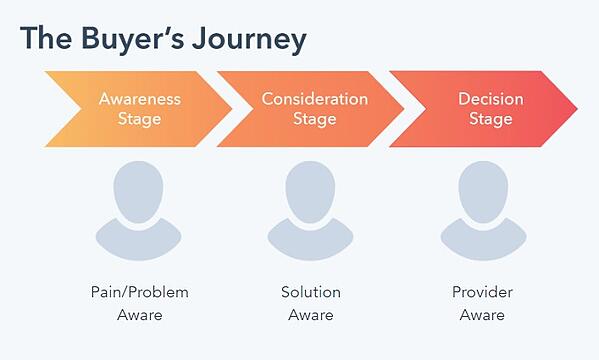
Awareness Stage
In the awareness, stage customers have not realized the problem they have. In this situation, you would like to appear in front of them and convince them about how your product or service could help them cope with their difficulty. Broadcast channels could be an excellent method to attract your audience with your offer. As you are the first to make your target audience realize the problem, there is a high chance that they may consider your product or service.
Interest
In the interest, stage customers know their problem and are also interested in buying a product or service. However, they want more information about it and see that you offer solutions in this niche. Social channels are a great way to appear in front of the audience in the interest stage.
Desire
In their desire, stage customers want the product, but they try to compare and choose from a list of options. At this stage, it becomes crucial for you to come in front of your audience at the right time to be a step ahead of your competition. SEO, social channels and paid ads could be an excellent opportunity to communicate with the audience at the right time.
Decision
Customers already know which product to buy in the decision stage and have also shortlisted the companies. Paid ads again bring excellent opportunities at this stage. Many brands put ads on their competitors' branded keywords to steal the customers and be a step ahead. Hence many brands generally bid for their branded keywords to prevent the loss of their precious customers. Here is a complete guide on Amazon Listing Optimization.
Post action
Once a customer has trusted your brand and bought from you, it becomes essential for you to show that you value them. You could send direct emails to your customers verifying the transaction or additional information about the product on how they could use it.
Retention
It is well known that acquiring new customers is costlier than retaining an existing customer. Having an email list is highly crucial at this stage because you can send coupons or discounts to your current customers to bring them back in the buying stage and decrease the churn rate for your business.
Why does the digital marketing funnel now focus on a non-linear experience?
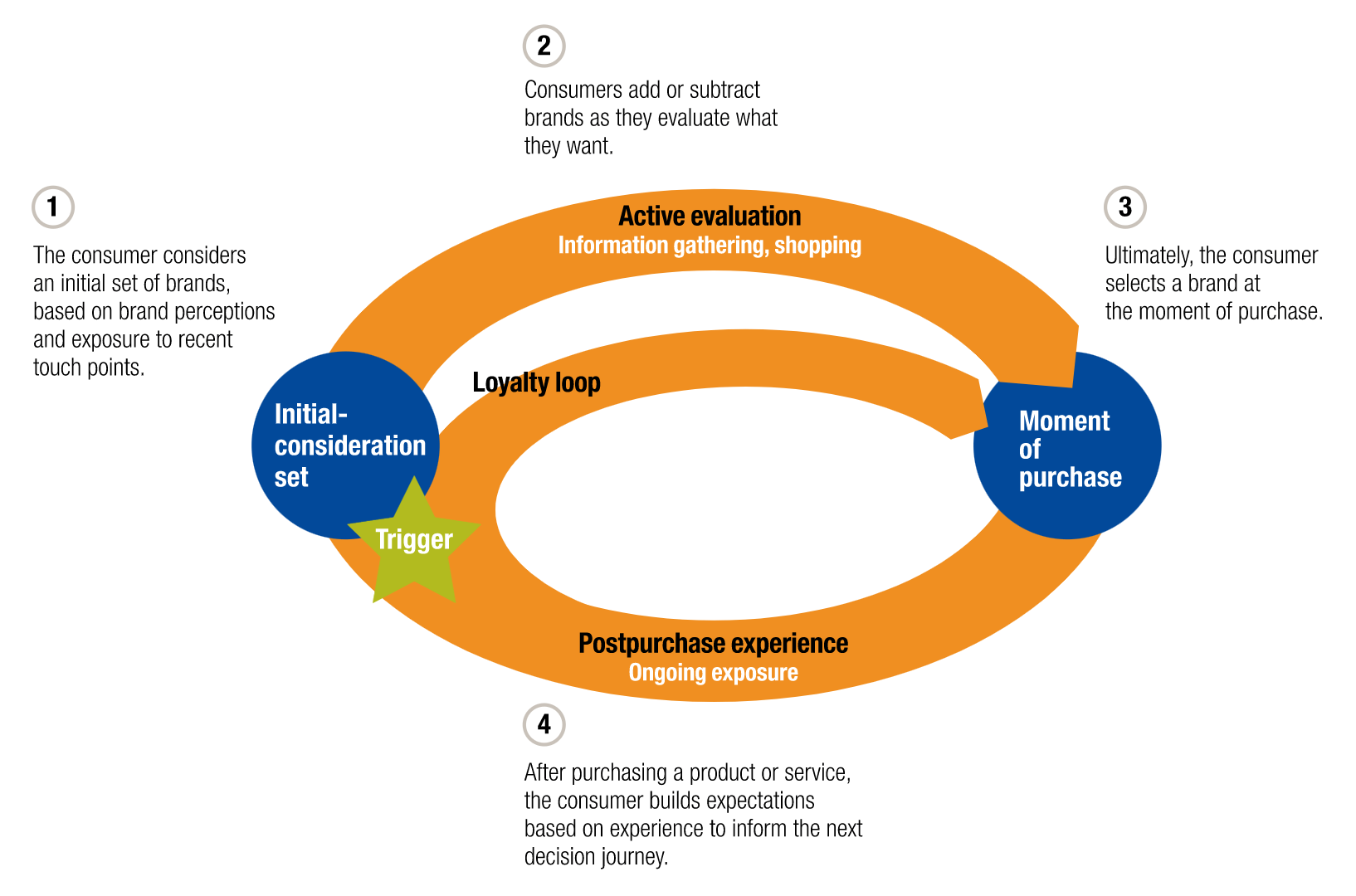
Non linear marketing funnel
The new trend in the digital marketing funnel is that users generally have a lot of information available to them now. With the rise of the internet age, the number of people using the internet has crossed 4 billion, and there are more than 2.5 billion smartphone owners. This ability has allowed the consumers to search for anything that they might be considerate about, in a single click, at any place, and buy products whenever they want and however they want.
With the amount of effort the companies, small businesses, and bloggers have put into content marketing, there has been an immense amount of information available to consumers. It is now a no-brainer for any person to browse articles, read reviews on social media, watch unboxing videos on YouTube, and focus on the overall experience of the previous buyers.
This has led to a change in the consumer behavior to the new shape, which made the linear marketing funnel somewhat ineffective. It failed to consider the different paths that a user can take now. This critical error made businesses miss opportunities and degraded the overall user experience.
The new and more sophisticated marketing funnel is the following:
Hourglass Digital Marketing Funnel
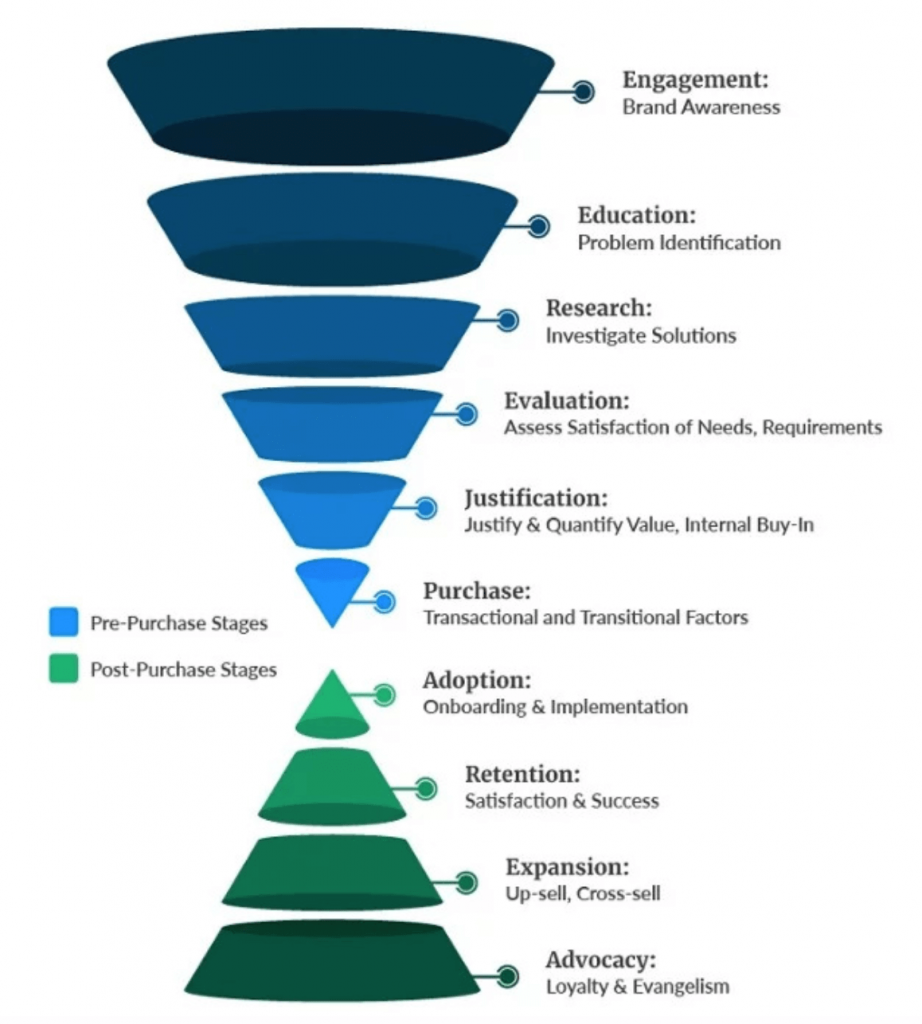
Hourglass Digital Marketing Funnel
The hourglass digital marketing funnel has 10 steps that focus on a detailed approach to the customer journey. This new digital marketing funnel process emphasizes the importance of maintaining a good relationship with existing customers, earning their loyalty, and making them the brand advocates and focusing heavily on the target audience.
In the pre-buying stage, the brands need to focus on the following six steps to have more holistic data and a better approach towards the customer journey based on the empathy map.
7 steps in the hourglass digital marketing funnel:
1. Engagement
2. Education
3. Research
4. Evaluation
5. Justification
6. Purchase
7. Adoption
8. Retention
9. Expansion
10. Advocacy
Engagement
The first step is building brand awareness and exposing yourself to the new markets are the potential customers who could be interested in buying your product or service. It becomes highly important for you to have strong market control and a long-lasting impact on the customers' minds in this competitive world atmosphere.
There are many options available to the potential customers, and the customer could have already been subjected to your competitor's content marketing or digital marketing campaign. In such a case, having a strong brand presence and effective online reputation management could help you bring more visitors and get more word of mouth.
Education
You would be amazed to know that around 93% of the online experiences begin on search engines. In such a case, you need to have a strong content marketing and search engine optimization campaign so that your target audience come on your website every time they have a query. For example, sit back and think how many times you search on Google for your queries, search for service providers, or be a product.
Most of the time, if you land on a specific website with a lot of good content that solves your query, you could subconsciously develop unknown advocacy for that brand. If you were to make a new decision on who you should choose for buying a product or service, it is possible to look for that specific website with more authority and credibility.
Research
In the next stage of this digital marketing funnel, your customers would be looking for service providers or product sellers online. They are looking forward to discovering a solution and having a list of options available to them. Therefore, you need to have a strong digital marketing campaign and be ready to capitalize on these moments.
Evaluation
Your customer would then evaluate the options available to them and determine how that product or service would resolve a problem. Therefore, you need to have credibility in the market and build a strong brand presence that would ultimately push your customer to believe in you and finally purchase from you.
Justification
Today's customers are more knowledgeable and have access to almost every information they would ever need. Hence, it becomes a no-brainer that they would justify and validate the product or service. You need to have some good reviews and case studies that would help you earning the confidence of your consumer.
Purchase
This is the most important stage for you when your customer buys the product or service. You could build a strong search engine marketing campaign for your branded keywords so that your customers don't land on your competitor's website who might choose to put ads for your branded keywords on Google.
Now, in the post-buying stage, it becomes crucial for you to retain these customers so that your customer acquisition cost decreases and each customer's lifetime value increases. So, again, this metric could help you be more profitable and let you know how you have been performing in your marketing.
Adoption
The customer onboarding process must be as smooth as possible so that you don't lose customers in the early hours. Your customers would only repeat purchases from you if they see the value in what you offer. And, the best way to let your customers adopt your offer is by letting them use the product in their day-to-day life.
Retention
For any business, retention is one of the most important aspects of marketing and sales, as a high churn rate would equate to lesser stability in the business and revenue. Furthermore, it is well-known that acquiring new customers is costlier than retaining existing customers.
Expansion

upsell and cross sell
If you have good customer service and your product fulfills the need of your consumer, you have a good chance that your customer will like you. In such a case, when you have the authority and trust, you could easily upsell and cross-sell to your existing consumers to increase your revenue and overall lifetime value of the consumer.
Advocacy
The last step of this digital marketing funnel is to make sure consumers become the brand advocates. Again, the word of mouth marketing is the strongest form of marketing that could get you more consumers and more authority in the market.
The loyalty loop [Digital Marketing Funnel]
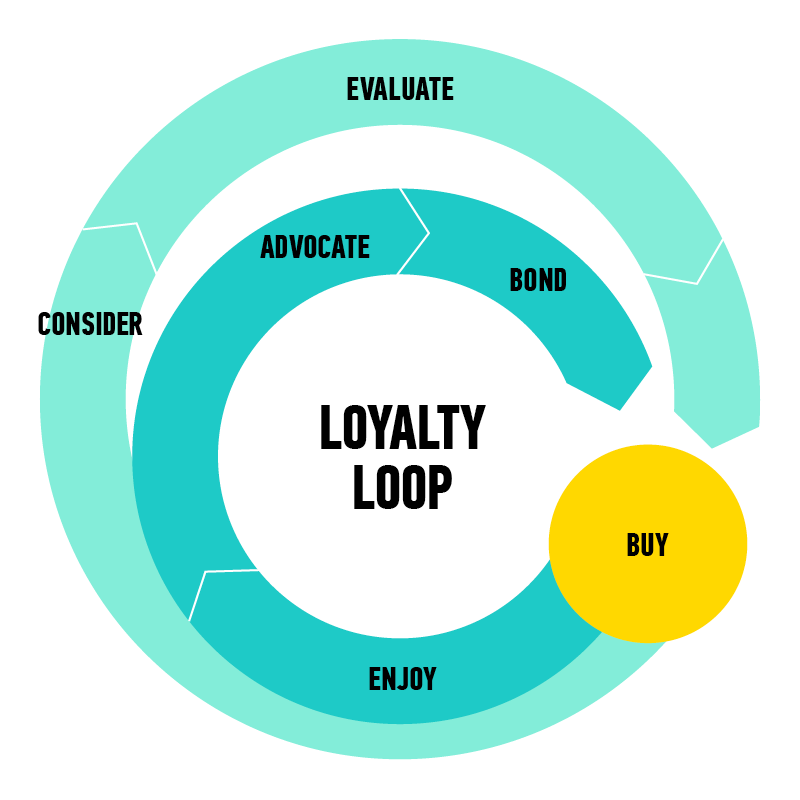
The loyalty loop in digital marketing funnel
In the loyalty loop, the customers get a trigger that a brand is an option. This feeling and trigger let the consumers consider the available options and move to the evaluation process. In this new stage, the consumers focus on gathering information and comparing their options. After this process, when the consumer is fully satisfied with the information and the options, they ultimately move forward to buy the product. However, in the loyalty loop marketing funnel, the consumers' post-purchase experiences dictate whether the existing customer would return and re-purchase or look for alternatives.
As the consumers have a lot of information and options available to them, they are constantly re-evaluating the decision to continue using a product. Once the consumer enjoys using a product, has a good experience with your customer support, gets what he wants, and ultimately reaches the objective behind purchasing, they would again come back to you to purchase the product. Now they are in a loop where they love product or service and actively use it. The next process is being the advocate of your brand and spreading word of mouth for free.
Finally, if they are still good with your brand and use your product, then possibly they could develop a strong bond with your brand and be your most valuable customers. This loyalty loop accounts for experiences the consumer has with the brand that affect their long-term loyalty after the initial purchase.
Micro-Moments Digital Marketing Funnel
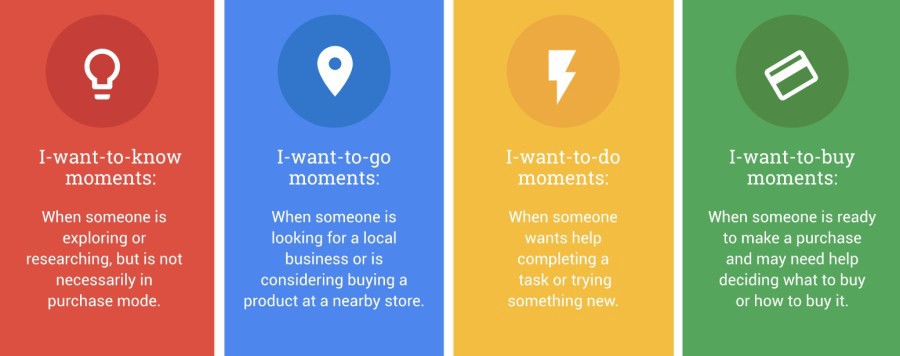
Micro moments digital marketing funnel
The micro-movement concept by Google focuses on the motivation that drives your user to enter your digital marketing funnel.
Micro moments digital marketing funnel consists of four moments:
1. Want to know moment
2. Want to do moment
3. Want to go moment
4. Want to buy moment
Want to know moment
Your customer needs answers to their questions before moving down the marketing funnel. Therefore, you need to have a strong content marketing campaign and ongoing marketing process to continually answer the possible questions that could arise in the mind of your target audience. In addition, it would be best if you also covered the new industry topics and the trends in the market so that you perform the best in this want-to-know moment.
Want to do moment
As mobile phones have become a part of our daily lives, there has been a fundamental change in consumer behavior and how people behave with digital media. Hence, in the want to do moments, your target audience might look forward to discovering something, watching something, or learning something.
Want to go moment
In the want-to-go movement, your target audience might want to go to your physical shop or your digital shop, also known as your website. In such a case, you need to have a strong digital presence, and your website should be attractive to captivate the attention of your viewers. Also, you need to put all the information regarding your physical shop on your website so that consumers don't get confused and have the best experience with your brand.
Want to buy moment
In the want to buy moment, your consumer wants to purchase something. Therefore, it requires you to have solid digital marketing campaign that would allow you to be available to your consumer in the easiest manner possible. For example, you could buy ad space for your branded keyboard so that your competitors don't get the opportunity to steal your audience.
Click Funnels
A click funnel comprises a sequence of landing pages designed to guide users toward a specific conversion event. These funnels hold a significant role within your lead generation and broader digital marketing strategies. Typically, individuals enter a click funnel via a link featured in a social media post, a paid search ad, or an email, often facilitated by marketing automation. This link directs the prospect to a landing page tailored to a particular product or service offered by your business.
With click funnel marketing, leads are generated through these landing pages, and these leads may traverse multiple subsequent pages containing additional offers and upsells before eventually converting. It's important to note that reaching the end of a click funnel and achieving a conversion doesn't always equate to a purchase. Conversions within click funnels encompass various actions, including downloading a whitepaper or registering for a webinar.
Several instances of click funnel applications encompass:
- Signing up for an email newsletter
- Downloading a whitepaper
- Registering for blog post notifications via email
- Obtaining infographics
- Accessing an eBook guide related to your industry, product, or services
- Enrolling in a webinar
For prospects who express interest by seeking more information or subscribing to your email list, a valuable opportunity emerges to guide them from free content toward a paid purchase through the process of upselling. Click funnels are particularly effective tools for businesses offering add-on or tiered products.
Content Marketing Funnel
A content marketing funnel offers content marketers a visual framework for effectively utilizing existing content to attract potential customers and navigate them through their journey until they achieve their desired outcome. This desired outcome could encompass a sale, a demonstration, a download, or any other type of conversion.
Each segment of the funnel serves a distinct purpose, ranging from capturing attention and generating high-quality leads to finalizing conversions.
A marketing funnel also grants brands enhanced insight into potential content gaps along the customer journey. For instance, if a brand possesses ample content tailored to buyers in the awareness stage but lacks sufficient content in the decision stage, they might consider shifting their focus towards producing more content for the final stages of the funnel.
When evaluating each content piece, it becomes crucial to align them with the corresponding stage of the buyer's journey. These stages encompass:
- Top of the funnel (TOFU): The awareness stage, where potential customers seek information.
- Middle of the funnel (MOFU): The interest and consideration stage. Here, potential customers examine your products or services and read customer reviews. They might also share this information with key stakeholders.
- Bottom of the funnel (BOFU): The intent, evaluation, and conversion stage. At this point, buyers are prepared to proceed with their purchase decisions.
By examining each stage individually, it becomes evident that your target audience requires diverse content pieces based on their specific position within the funnel.
Metrics for your Marketing Funnel
|
Metric
|
Description
|
|---|---|
|
Awareness Stage
|
|
|
Brand Awareness
|
Measuring the recognition and familiarity your brand garners within your target audience.
|
|
Reach and Impressions
|
Evaluating the extent of your content's visibility across platforms, including social media, search results, and other online channels.
|
|
Engagement Rate
|
Assessing the level of interaction and engagement your content generates among your audience.
|
|
Social Media Reach
|
Evaluating your brand's presence and engagement on social media platforms.
|
|
Organic Search Traffic
|
Measuring the volume of visitors directed to your website through organic search results.
|
|
Interest and Consideration Stage
|
|
|
Website Traffic
|
Gauging the volume of visitors your website attracts, reflecting interest in your offerings.
|
|
Content Consumption
|
Tracking the consumption rate of your educational materials, such as blog posts, videos, and guides.
|
|
Lead Quality
|
Measuring the relevance and potential of leads generated during this stage.
|
|
Click-Through Rate (CTR)
|
Assessing the percentage of users who click on your content or offers after seeing them.
|
|
Lead Magnet Effectiveness
|
Measuring the success of lead magnets, such as ebooks or webinars, in capturing valuable leads.
|
|
Decision and Intent Stage
|
|
|
Conversion Rate
|
Determining the proportion of leads that transition into actual conversions, such as sign-ups, demo requests, or inquiries.
|
|
Lead Nurturing Efficacy
|
Evaluating how effectively your nurturing efforts guide leads through the decision-making process.
|
|
Customer Feedback
|
Gathering insights from prospects and leads regarding their perceptions and needs.
|
|
Trial Sign-Ups
|
Tracking the number of users who sign up for trials or demos of your products or services.
|
|
Proposal Acceptance Rate
|
Evaluating the ratio of proposals submitted to clients to those accepted, indicating the effectiveness of your offers.
|
|
Purchase and Conversion Stage
|
|
|
Sales Revenue
|
Calculating the revenue generated through completed transactions.
|
|
Customer Acquisition Cost
|
Analyzing the expenses associated with acquiring new customers, providing insights into the efficiency of your marketing efforts.
|
|
Customer Satisfaction
|
Measuring the level of satisfaction among customers who've completed a purchase or conversion.
|
|
Average Order Value
|
Calculating the average value of each transaction, aiding in revenue prediction and analysis.
|
|
Customer Lifetime Value
|
Estimating the potential long-term value a customer can bring to your business, helping with customer retention strategies.
|
|
Churn Rate
|
Assessing the rate at which customers stop engaging or unsubscribe, highlighting areas for improvement.
|
Marketing funnel for B2B
Digital marketing funnels are a pivotal part of our day-to-day business strategy for our clients. For B2B clients, it is especially important to have a well-defined funnel to drive business growth. A digital marketing funnel is the path potential customers take toward becoming real clients. It is important to note that a digital marketing funnel is not a linear process and can vary depending on the company and the industry.
The distinction arises from the fact that businesses approach purchasing decisions in distinct manners compared to individuals. Businesses often allocate greater funds, invest more time, and involve a larger number of stakeholders, especially in cases of high-value acquisitions. As a result, the process tends to be extended and intricately woven. Indeed, 77 percent of B2B purchasers report that their most recent buying experience was highly intricate. Furthermore, the B2B purchasing process tends to be more protracted, with 74.6 percent of B2B transactions requiring a minimum of four months for completion, and almost half of them extending to 7 months or even longer. Given these circumstances, it becomes progressively crucial for B2B enterprises to allocate resources to refining both their marketing and sales funnels, ensuring their optimal functionality.
In most cases, many different people are part of the decision-making process at various stages of the marketing journey. This means both the marketing and sales teams need to connect with different types of people with different needs. Usually, the person who shows interest in the product or service isn't the one who ultimately decides to buy. So, in a B2B marketing plan, this difference has to be considered.
In a practical sense, a good B2B marketing plan should involve interactions with various people from the client's business. This could be anyone from the boss and managers to supervisors and accountants, and more.
By including these important people right from the start, the marketing team can make things easier by creating materials that make sense to everyone involved, not just the first person who showed interest.
B2B Digital marketing funnels are essential for businesses as they provide a roadmap for generating leads and driving sales. By utilizing the four stages of a digital marketing funnel, we can create an effective strategy to convert potential prospects into actual customers and ensure customer loyalty.
Marketing funnel for B2C
The AIDA version of a marketing funnel is crafted keeping the customer in focus, making it an ideal fit for business-to-consumer (B2C) sales. In this scenario, since the individual serves as both the initial point of contact and the decision maker, marketers only need to cater to one person rather than multiple individuals within a larger organization. Due to this, it's advisable to construct distinct marketing funnels tailored to specific demographics or user groups. This approach ensures that both the marketing and sales teams adhere to the same plan, addressing identical concerns to guide the lead along the funnel.
Hence, rather than developing an intricate network of different pathways for each segment, it's more effective to establish entirely separate funnels.
B2B VS B2C funnels
|
Aspect
|
B2B Sales Funnel
|
B2C Sales Funnel
|
|---|---|---|
|
Sales Funnel Stages
|
6 stages
|
4 stages
|
|
Sales Cycle Duration
|
Longer
|
Shorter
|
|
Target Audience
|
Group
|
Individual
|
|
Preferred Social Networking Platforms
|
LinkedIn
|
Facebook, Instagram, Twitter
|
|
Audience Reach Strategies
|
Content marketing, referrals, research
|
Traditional marketing, paid media, referrals, research
|
|
Stage 1: Awareness
|
Identifying needs, problem-solving
|
Identifying needs, problem-solving
|
|
Stage 2: Interest
|
In-depth audit, reviewing services/products
|
In-depth audit, reviewing services/products
|
|
Stage 3: Consideration
|
Group involvement, deeper research
|
Research, comparisons, evaluating competitors
|
|
Stage 4: Intent
|
Formal pitches, demonstrations, proposals
|
Demonstrations, quotes, adding to cart
|
|
Stage 5: Evaluation
|
Reviewing research, pitch evaluation
|
Evaluating pitch, proposal, comparing competitors
|
|
Stage 6: Buy
|
Purchase decision, contract signing
|
Completed transaction, product on its way
|
|
Post-Sale Relationship
|
Establishing lasting relationship, communication
|
Encouraging reviews, sign-ups for updates
|
|
Characteristics
|
- Transactions with other businesses
|
- Targets individual consumers
|
|
|
- Sells to a group
|
- Shorter sales cycle
|
|
|
- Involves multiple decision-makers
|
- Can be as short as 5 minutes
|
|
|
- Longer sales cycle
|
- Can leverage traditional marketing methods
|
|
|
- Content marketing crucial
|
- Emphasizes online shopping
|
|
|
- Focuses on educating and building trust
|
- Faster decision-making
|
|
|
- Delays in evaluation due to group consensus
|
- Evaluates product details quickly
|
|
|
- Relationship building for lasting engagement
|
- Focuses on immediate desire and conversion
|
11 steps to create a successful digital marketing funnel for your business:
1. Define Your Audience
2. Research Your Competition
3. Set Achievable Goals
4. Create a Content Strategy to solve your customer's queries
5. Design a Website That Converts
6. Analyze and Optimize Your Funnel
7. Create content and advertising campaign.
8. Create a landing page to demonstrate your expertise.
9. A/B testing is crucial to find the best versions
10. Be always available to your audience
11. Create a strong brand presence and recall value
You could follow these steps to create a successful marketing funnel:
1. Define Your Audience
The first step in creating a digital marketing funnel that converts is to define your audience. You need to understand who your customer is, what their needs and wants are, and how you can best serve them.
Once you know your target market, you can create customer profiles that will help you create targeted content and messaging that will resonate with them. You can also use this information to determine the best channels to reach them and the type of content they're most likely to respond to.
While selecting an audience, you might want to explore some affiliate networks. Do it wisely as some are not safe, but others are a good opportunity to bring in traffic at very low cost.
2. Research Your Competition
Now that you know your ideal customer and what you want to offer them, it's time to research your competition.
What are they doing that's working? What are they doing that's not working? How can you differentiate yourself and create a unique funnel that will convert better than your competitors'?
The key is to always be learning and tweaking your funnel so that it's the most effective it can be. Use your competition as inspiration, but don't copy them outright. There's no need to reinvent the wheel, just make it better.
3. Set Achievable Goals
Now that you have a basic understanding of the digital marketing funnel, it's time to set some achievable goals. Remember, the goal of the funnel is to convert website visitors into paying customers. So, your goals should be based on what you want your customers to do: buy a product, sign up for a newsletter, download a white paper, etc.
Once you have your goals in place, it's important to create a plan of action that will help you achieve them. This plan should include all of the steps you need to take from start to finish, from creating attractive content to enticing users to click through to your website. It's also important to set a realistic timeline for completing each step so you don't get overwhelmed.
4. Create a Content Strategy to solve your customer's queries
Now that you understand the different stages of the funnel, it's time to create a content strategy that will help you convert leads into customers. This means creating content that is relevant and helpful to your target audience at each stage of the funnel.
In the awareness stage, your goal is to capture the attention of potential customers and introduce them to your product or service. This means creating content that is interesting, informative and persuasive. You can do this by sharing blog posts, articles, infographics, images, social media updates and more.
In the consideration stage, your goal is to help potential customers learn more about your product or service and compare it with other options. This means creating content that is detailed and compares your product or service with others. You can do this by creating videos, case studies, e-books, cheat sheets and more.
In the purchase stage, your goal is to convince potential customers to buy your product or service. This means creating content that is persuasive and inspires confidence. You can do this by creating testimonials, product demos, webinars, pricing pages and more.
5. Design a Website That Converts
Now that you understand the basics of creating a digital marketing funnel, it's time to design your website. Remember, the goal of your website is to convert visitors into leads, so you need to make sure it's designed for optimal conversion. Here are a few tips to help you get started:
1. Use simple, clear language on your website. Don't try to overload your visitors with too much information.
2. Make sure your website is easy to navigate. Visitors should be able to find what they're looking for quickly and easily.
3. Use images and videos to break up the text and keep things interesting.
4. Make sure your CTA buttons are easy to see and clickable.
5. Test different versions of your website to see which one converts the best.
6. Analyze and Optimize Your Funnel
After taking all the aforesaid steps, it's time to analyze and optimize yours. The best way to do this is by using data from your Google Analytics account.
Google Analytics is a free tool that gives you detailed information about how people are finding and interacting with your website. It can help you track things like how many people visit your website, where they come from, what pages they visit, and how long they stay on your site.
By analyzing this data, you can identify areas of your funnel that need improvement and make changes that will increase your conversion rate.
7. Create content and advertising campaign.
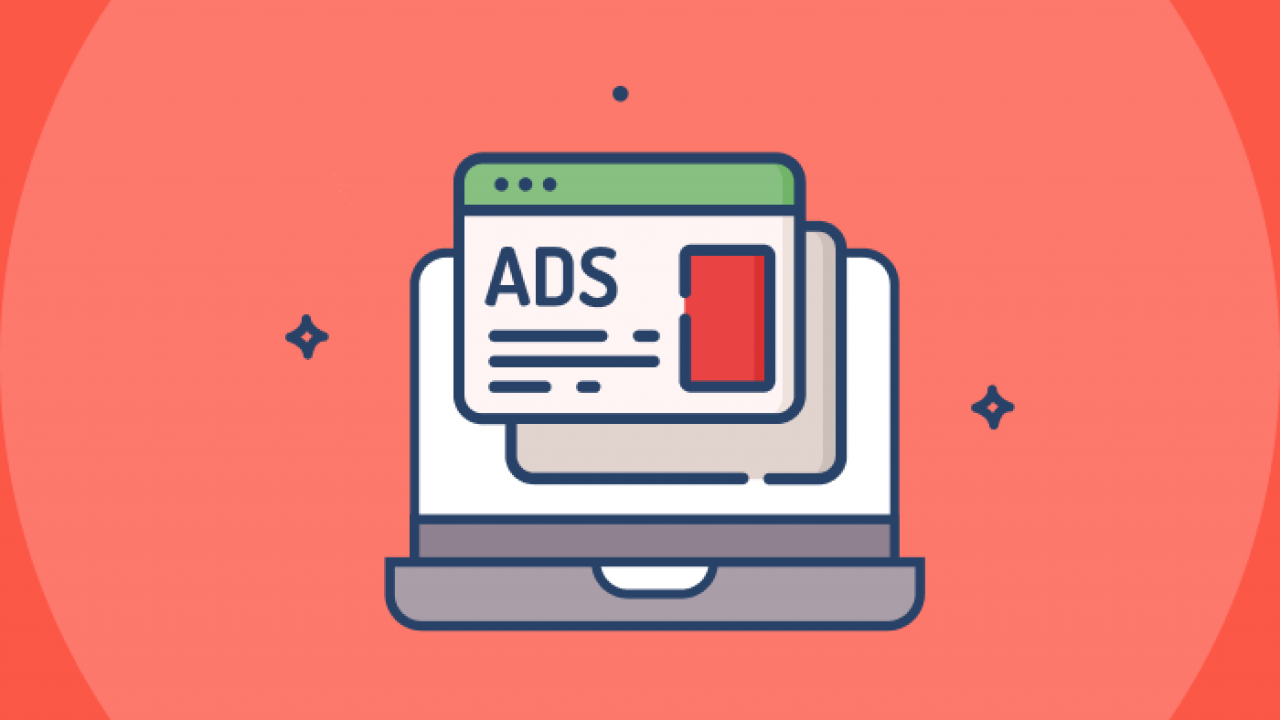
run a detailed campaign
As discussed above, the primary stage of a digital marketing funnel is awareness; thus, you would like to make sure that whenever your customer persona searches for their problem, they find you at the top of SERP results. It brings exposure to you and your business, and people tend to trust your company if they find at least 3 to 4 content that solves the problem. Creating a blog post that may resonate with your customer persona and investing in search engine optimization could help in the long run. You may hire an SEO agency or build an in-house team to look after your SEO efforts. As search engine optimization is a long-term play, you would also like to invest in advertisements on platforms like Facebook, YouTube, etc.
Facebook, YouTube, Instagram, and Pinterest have better performance results for B2C campaigns, whereas LinkedIn and Twitter are better platforms for B2B marketing.
Attract your audience with exciting offers.
Email marketing is one of the most prominent digital marketing channels to communicate with your audience directly and promote your offer. It is a great technique to earn a reputation by providing valuable resources like e-books, case studies, free trials, cheat sheets, etc., to your audience to entice them. At this stage, it becomes crucial for you to differentiate between your target audience and what they prefer.
8. Create a landing page to demonstrate your expertise.
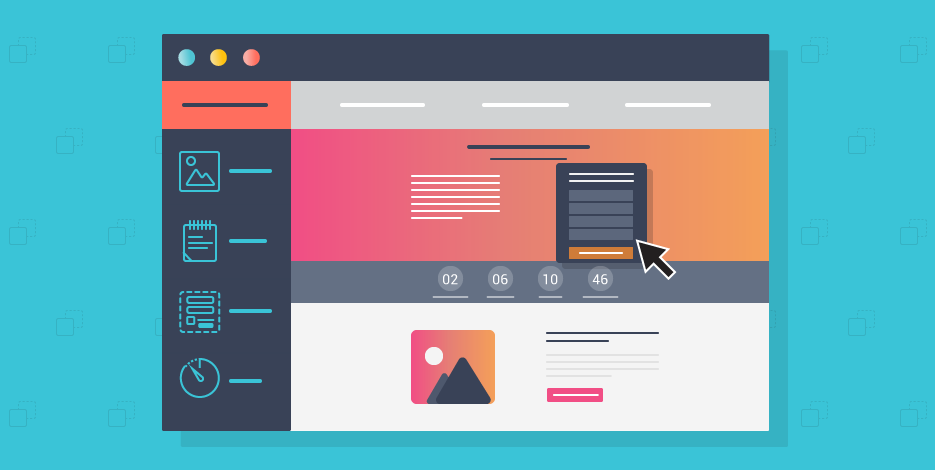
have a well-planned landing page
Once you have placed an ad, it becomes vital for you to optimize the landing page so that customers don't feel the ad spammy or confusing. Your landing page should have a complete description of your offer and clear and attractive visuals. You would like to include a form for people to put their contact information so that you could follow them later.
If you put testimonials and security badges on your landing page, people would be more comfortable sharing the details with you. Even if a person has landed on your landing page, it is your responsibility to address the next step. Depending on your campaign objective, you might want to include a compelling call to action like 'Buy now' or 'Subscribe to the newsletter.'
9. A/B testing is crucial to find the best versions
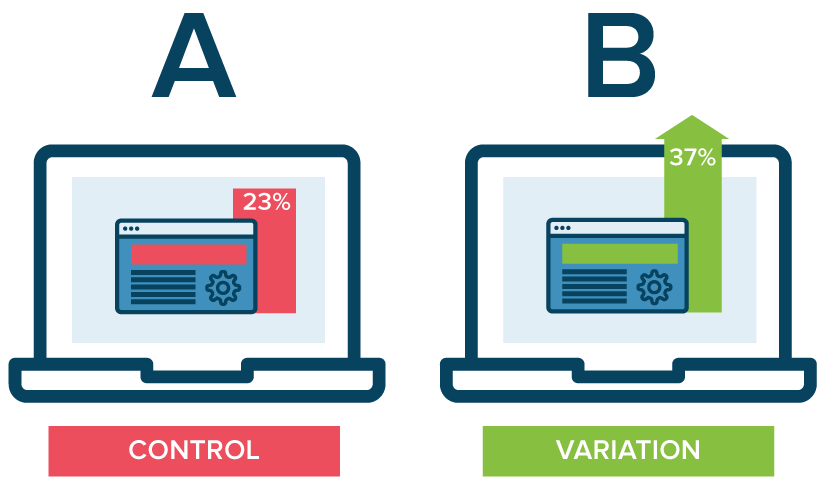
A/B testing can help you optimize campaigns
A/B testing is the process in which you compare two versions of your landing page and compete these ad copies against each other to finalize which one performs better. In this test, you show one kind of landing page to half of your traffic and the modified version to the remaining half randomly.
Depending on the results, you can determine which one brings better and positive customer behavior.
10. Be always available to your audience
In this new age of customer experience, you cannot overlook assisting your consumers anytime or any day. Most consumers purchase a product based on the motivation that drives them down the funnel. And, they could lose this heat of the moment and postpone their decision if they don't get assistance when they want. You could use chatbots and train them to react to your customer's doubts and queries.
You could also create an effective FAQ section and answer all the frequently asked questions. Along with that, if you are a big brand and can afford to have a dedicated team, then you could hire them based on shifts; the first group would work in the day while the other one would work in the night to ensure that your consumer has the best user experience in your industry.
11. Create a strong brand presence and recall value
In this new era, when the consumers have many options available to them on the table, you must focus on creating a strong brand presence and brand value that would help you distinguish yourself in this competitive atmosphere.
You need to demonstrate to your users that you care for them and understand their unique pain points, no matter at which digital marketing stage they are. SEO and content marketing could help you enhance your brand presence. Also, try to have testimonials on your website and strong social media presence to help your consumers understand that you would align with their user expectations and that your product would fulfill their needs.
Use our digital marketing funnel template
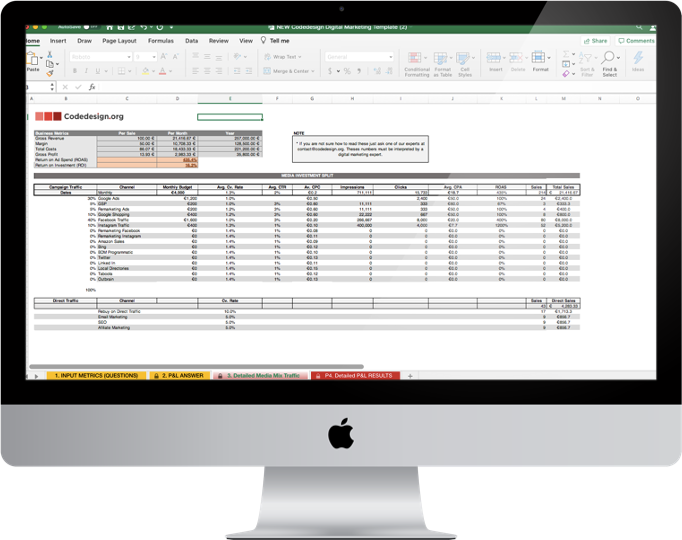
Use our template to design a comprehensive digital marketing funnel, using a mix of media strategy and organic traffic.
DOWLOAD FREE DIGITAL MARKETING FUNNEL TEMPLATE HERE!
Conclusion
A digital marketing funnel is the visual representation of the steps a customer takes in the customer journey. The most crucial step in the customer journey is understanding your target audience's pain points and figuring out how to help them and communicate the value to them.
Once you know your customer, you can easily create personalized content and advertisement copies to share with them in the best of manners.
Here is a complete guide on the latest revolution - Voice Search Optimization
FREQUENTLY ASKED QUESTIONS
1. What are the 4 major phases of funnel marketing and explain them?
Awareness: The potential customer becomes aware of the problem that your product or service can solve.
Interest: The potential customer becomes interested in your product or service as a potential solution to their problem.
Decision: The potential customer decides whether or not to purchase your product or service.
Action: The potential customer takes action, either by purchasing your product or service, or by taking some other desired action.
2. Why is digital marketing funnel important?
Digital marketing funnel is important because it allows businesses to track and measure the performance of their marketing campaigns. By understanding the customer journey, businesses can identify areas where they need to improve their marketing strategies. Additionally, businesses can use digital marketing funnel to target specific customers and segments with personalized messages. A digital marketing funnel is important because it helps to track the progress of potential customers as they move through the sales process. It allows marketers to identify and target the right prospects with the right messages at the right time. It also helps to measure the success of marketing efforts and optimize campaigns for better results. Finally, a digital marketing funnel can help to identify potential problems in the customer journey and make changes to improve customer satisfaction and conversion rates.
3. What is funnel strategy?
A funnel strategy is a way of thinking about your marketing efforts in terms of a funnel. The idea is that you want to attract as many people as possible into the top of the funnel (TOFU), then move them through the middle of the funnel (MOFU), and finally convert them into customers at the bottom of the funnel (BOFU). This entire process is focused on providing personalized experience and nurture relationships and build better brand experiences.
4. What is tofu (top of funnel) marketing?
Top of funnel marketing is the process of generating awareness and interest in a product or service through marketing activities that reach a wide audience. These activities can include paid advertising, public relations, and content marketing. Tofu (top of funnel) marketing is a type of marketing strategy that focuses on creating awareness of a product or service at the very beginning of the customer journey. This type of marketing typically involves activities such as content marketing, email marketing, search engine optimization (SEO), and social media marketing. The goal of Tofu marketing is to generate interest in your product or service by providing valuable and engaging content to potential customers.
5. What is mofu (middle of funnel) marketing?
Middle of funnel marketing refers to the activities and strategies used to engage customers and prospects who are further along in the buyer’s journey and are thus more likely to be interested in and have a need for your product or service. Mofu (middle of funnel) marketing is a type of marketing strategy that focuses on attracting potential customers who are already familiar with your brand, product, or service. It is focused on engaging users who have already taken an interest in your product by providing content such as webinars, case studies, product demonstrations, and more. The goal of mofu marketing is to further drive engagement and conversions by providing content that will help the customer make a purchase decision.
6. What is bofu (bottom of funnel) marketing?
Bottom of funnel marketing is a type of marketing that is focused on generating leads and converting them into customers. It usually includes activities such as lead generation, lead nurturing, and lead conversion. Bofu (bottom of funnel) marketing is a marketing strategy that focuses on converting leads into customers. This type of marketing strategy typically involves providing highly targeted content and offers that are designed to appeal to potential customers in the later stages of the buying process. Content typically includes product demonstrations, comparison charts, webinars, and case studies. Bofu marketing is designed to help close the sale and convince potential customers to make the purchase.
More about CodeDesign
Codedesign is a digital marketing agency specializing in e-commerce and B2B online marketing. It utilizes the latest digital marketing tools and strategies to help its clients reach their business goals. It offers comprehensive services such as website design, search engine optimization (SEO), content marketing, performance marketing, social media marketing, CRM, email marketing, and more. These experts create and implement customized digital marketing campaigns to increase website traffic, generate leads, and drive sales. Our expertise in e-commerce and b2b marketing allows us to understand the nuances of the digital marketplace and create effective marketing solutions tailored to their client's needs.
CodeDesign is leading:
- Digital Agency
- Digital Marketing Agency
- Amazon Marketing Agency
Feel free to contact us to see the unprecedented growth of your business.
Author

|
Author: Bruno Gavino. CEO of Codedesign. Head of Digital. Board Advisor at GLC Group. Board Advisor at CCLI. Board Advisor at ILC. Board Advisor at Portugal Ventures. Digital Marketing. |
|
His proficiency isn't just confined to executive roles; he extends his insights and expertise as a Board Advisor for a range of esteemed organizations. These include the GLC Group, CCLI, ILC, and Portugal Ventures. Each of these advisory roles speaks to his versatility, showcasing his ability to provide strategic guidance across diverse sectors and platforms. Rooted in a deep understanding of digital marketing, Bruno's influence has had a ripple effect, enabling businesses to harness the power of digital transformation and innovative marketing strategies. His leadership and advisory roles, combined with his commitment to pushing the boundaries of digital marketing, solidify his position as a key figure in the evolving digital landscape. |



Add comment ×